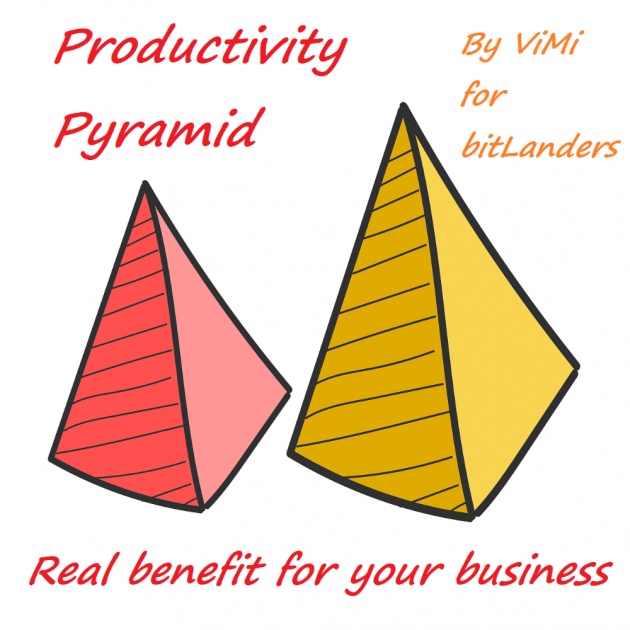
A productivity pyramid implies involvement in business optimization for every employee and a maximum of customer orientation. The starting point of the productivity pyramid is a value of the consumer. From the perspective of the buyer, the product (service) acquires real value only when there is direct handling, manufacturing of the necessary elements. The heart of the productivity pyramid is the elimination of losses, which in Japanese are called "muda." Muda is a Japanese word that means the loss, the waste, i.e. any activity that consumes resources but creates no value. For example, consumers do not need a ready product or its parts storing in the warehouse. However, in the traditional system, management of storage cost and all costs associated with alterations, defects, and other indirect costs is passed on to consumers.
All the activities of the enterprise can be classified as operations and processes that add value to the customer, and the operations and processes that do not add value to the consumer. Therefore, everything that does not add value to the consumer, from the point of view of the productivity pyramid, is classified as a loss and should be eliminated.
Two more sources of waste are distinguished, "muri" and "mura," which mean respectively "overload" and "irregularity":
Mura – unevenness of work, for example, fluctuating work schedule, not caused by fluctuations in the demand of final consumers, but rather the characteristics of the production system, or an uneven work pace in an operation is completed, forcing the operators to hurry and then wait. In many cases, managers are able to eliminate the unevenness of any cost due to the alignment of planning and careful attention to the pace. Muri in work – overload equipment or operators arising from the work with greater speed or tempo and with great effort over a long period of time in comparison with the design load (project, labor standards).

Basic principles:
1) determine the value of a particular product;
2) define the value stream for this product;
3) ensure the continuous flow of the value stream of the product;
4) allow the user to pull the product;
5) strive for excellence.

Other principles to avoid muri in work:
- Excellent quality (renting from the first presentation, the system zero defects, detecting and solving problems at the forefront of their occurrence);
- Flexibility;
- Establishing long-term relationships with the customer (by dividing the risks, costs, and information).
Tools of the productivity pyramid: a system jidoka and "just in time".
Jidoka means "stretching," that is the idea that the subsequent processing stage asks for the desired products with the previous one, but until then, nothing is done.
Just in time – synchronization system transfer product from one production stage to another. Components must be passed to the next stage only when it is needed, and not a minute before.
The productivity pyramid is impossible without a lean culture. Lean culture is the human factor, teamwork. A significant support is having the emotional intelligence (EQ) of employees. Lean culture corresponds to a definite corporate culture.

Efficiency after removing muri in work
In general, the use of the productivity pyramid can yield significant effects. Application of tools and methods of lean production allows achieving a significant increase of efficiency and activity of enterprises, labor productivity, improving product quality and competitiveness without significant capital investment.
With the help of lean manufacturing to streamline services and communication between the customer and the supplier, a process of delivery and production services can be optimized. Regular international and regional conferences, many of which bring profit and are led by the Lean Enterprise Institute (USA) and Lean Enterprise Academy (UK), contribute to the spread of these ideas. In many countries, the spread of lean production is supported by the government. During the greatest competition and the crisis worsening, companies all over the world have no other way to avoid extra cost than using the world's best management technologies to create products and services that satisfy customers at quality and price.
Organizational and administrative culture is determined by the adequacy, completeness, relevance, and clarity of the normative administrative documents that regulate the powers and responsibilities of staff, planning, implementation, monitoring, evaluation and analysis of different types of work.

It is amazing how the productivity pyramid changes the hierarchy in the company structure. Instead, managers and staff formed a community of multi-skilled staff. Anyone can suggest an improvement, everyone can check his idea into practice, and everyone is responsible for a comprehensive result. This flexibility allows making changes instantly, and thus respond to consumer demands, attacks of competitors and the excitement of the market.
The main task of the top manager is to make a profit for the company. One of the ways to achieve it is solving problems and reducing the cost of production and the other focusing on creating "value" for the customer in the product or service. The most interesting thing is that by defining the right value for the customer, you can direct the team's strength and resources only on what's essential and cut spending on unimportant things.
The productivity pyramid helps saving money without sacrificing quality and throws out useless things. The essence of the transformation is to remove all muda, muri, and mura. Understanding their causal relationship can focus on the origins of the problems.

Principles of the productivity pyramid
Based on muda, mura, and muri, here are the 10 principles of the productivity pyramid:
- eliminate waste;
- minimize inventory;
- maximize the flow;
- production depends on consumer demand;
- know the requirements of customers;
- do it right for the first time;
- empower employees;
- build a system with easy replacement of parts;
- establish partnerships with suppliers;
- create a culture of continuous improvement.

There are also three basic tasks of the business. They guide the transformation of the entire company:
1) Goal. Which of the customers' problems does the company solve with the ultimate value to the consumer?
2) Process. What are the evaluation criteria of the value stream? Validation of algorithms and chains, fighting waste, unreasonableness, and congestion. Each step is valuable, feasible, affordable, adequate and flexible, and the streams and the influence of a uniform.
3) People. How to allocate responsibility for each process and production flow? Let a person be responsible not for the position, but the process. The curator of the task shapes the value creation from the perspective of business goals and actively embodies a lean transformation.

Examples of implementation of the productivity pyramid
The company's competitive edge often depends on certain criteria. Fast delivery of delicious pizza is better than just delicious pizza. Customization of the car from an official dealer is more interesting than a standard complication. The detailed medical tests are always better than a short statement from the local clinic. To provide a competitive advantage (speed, customization, quality of the research), one can continuously improve the project management system, as many companies in the world do.



